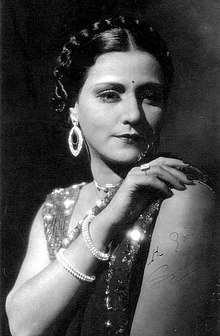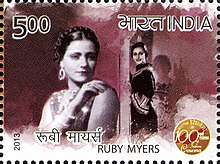Ruby Myers
Ruby Myers (1907 – 10 October 1983), better known by her stage name Sulochana, was an Indian silent film actress of Jewish ancestry, hailing from the community of Baghdadi Jews in India.
Sulochana | |
|---|---|
 Sulochana in the 1920s. | |
| Born | Ruby Myers 1907 Pune, Bombay Presidency, British India |
| Died | 10 October 1983 (aged 75–76) [1] Mumbai, Maharashtra, India |
| Occupation | actor |
| Years active | 1920s–1980s |
In her heyday she was one of the highest paid actresses of her time, when she was paired with Dinshaw Billimoria in Imperial Studios films. In mid-1930 she opened Rubi Pics, a film production house.[2]
She was awarded the 1973 Dada Saheb Phalke Award, India's highest award in cinema for lifetime achievement.
Film career
.jpg)
Ruby Myers was born in 1907 in Pune.[3] Chubby, petite and brown-eyed, the self-named Sulochana was among the early Eurasian female stars of Indian Cinema.
She was working as a telephone operator when she was approached by Mohan Bhavnani of Kohinoor Film Company to work in films. Though excited by the offer, she turned him down as acting was regarded as quite a dubious profession for women those days. However Bhavnani persisted with his offer and she finally agreed, despite having no knowledge of acting whatsoever. She became a star under Bhavnani's direction at Kohinoor before moving on to the Imperial Film Company where she became the highest paid movie star in the country.
Among her popular films were Typist Girl (1926), Balidaan (1927) and Wildcat of Bombay (1927) where she essayed eight roles including a gardener, a policeman, a Hyderabadi gentleman, a street urchin, a banana seller and a European blonde.[4]
Three romantic super hits in 1928 - 29 with director R.S. Chaudhari - Madhuri (1928), Anarkali (1928) and Indira B.A. (1929) saw her at her peak of fame in the silent film era. In fact so widespread was her fame that when a short film on Mahatma Gandhi inaugurating a khadi exhibition was shown, alongside it was added a hugely popular dance of Sulochana's from Madhuri, synchronised with sound effects.
With the coming of sound, Sulochana suddenly found a lull in her career, as it now required an actor to be proficient in Hindustani. Taking a year off to learn the language, she made a grand comeback with the talkie version of Madhuri (1932).
Further talkie versions of her silent hits followed and with Indira (now an) M.A. (1934), Anarkali (1935) and Bombay ki Billi (1936). Sulochana was back with a bang. She was drawing a salary of Rs 5000 per month, she had the sleekest of cars (Chevrolet 1935) and one of the biggest heroes of the silent era, D. Billimoria, as her lover with whom she worked exclusively between 1933 and 1939. They were an extremely popular pair - his John Barrymore-style opposite her Oriental 'Queen of Romance' image.
But once their love story ended so did their careers. Sulochana left Imperial to find few offers forthcoming. Newer, younger and more proficient actresses had entered the scene. She tried making a comeback with character roles but even these were few.
However, she still had the power to excite controversy. In 1947, Morarji Desai banned the Dilip Kumar - Noor Jehan starrer, Jugnu, because it showed such a morally reprehensible act as an aging fellow professor falling for Sulochana's vintage charms.
In 1953, she acted in her third Anarkali, but this time in a supporting role as Salim's mother.
Her films include Cinema Queen (1926), Typist Girl (1926), Balidaan (1927), Wild Cat of Bombay, in which she played eight different characters, which was remade as Bambai Ki Billi (1936); Madhuri (1928), which was re-released with sound in 1932; Anarkali (1928), remade in 1945; Indira BA (1929); Heer Ranjah (1929), and many others, such as Baaz (1953).
Sulochana established her own film studio, Rubi Pics, in the mid-1930s. She received the Dada Saheb Phalke Award in 1973 for her lifetime contribution to Indian cinema.[5] Ismail Merchant paid homage to her in Mahatma and the Bad Boy (1974).

She died in 1983 in her flat in Mumbai.
_(14245524943).png)
Selected filmography
- Cinema Queen (1926)
- Typist Girl (1926)
- Balidan (1927)
- Wildcat of Bombay (1927)
- Anarkali (1928)
- Heer Ranjah (1929)
- Indira BA (1929)
- Sulochana (1933)
- Shair (1949)
- Baaz (1953)
- Neel Kamal (1968)
- Mere Humdum Mere Dost (1968)
- Amrapali (1966)
- Julie (1975)
- Khatta Meetha (1978)
Further reading
- Great Masters of Indian Cinema: The Dadasaheb Phalke Award Winners, by D. P. Mishra, Publications Division, Ministry of Information and Broadcasting, Govt. of India, 2006. ISBN 81-230-1361-2. page 16.
- Actress Sulochana Cinema at the End of Empire: A Politics of Transition in Britain And India, by Priya Jaikumar, Duke University Press, 2006. ISBN 0-8223-3793-2. Page 73.
- The Hundred Luminaries of Hindi Cinema, by Dinesh Raheja, Jitendra Kothari. India Book House Publishers, 1996. ISBN 81-7508-007-8. page 1871
References
- Ruby Myers, Sulochana - Biography British Film Institute.
- Silent Screen Stars' India Heritage:Performing Arts:Cinema In India:Personalities:Silent Screen Stars.
- Queens of hearts The Tribune, 9 December 2007.
- Hansen, Kathryn (1998). "Stri Bhumika: Female Impersonators and Actresses on the Parsi Stage". Economic and Political Weekly. 33 (35): 2299. JSTOR 4407133.
- Madurainetwork.com - Dada Saheb Phalke Award
External links
| Wikimedia Commons has media related to Ruby Myers. |